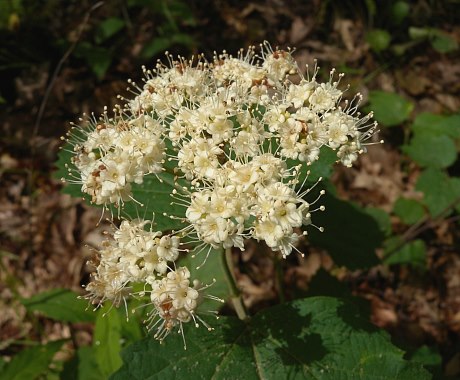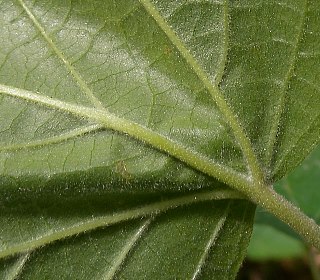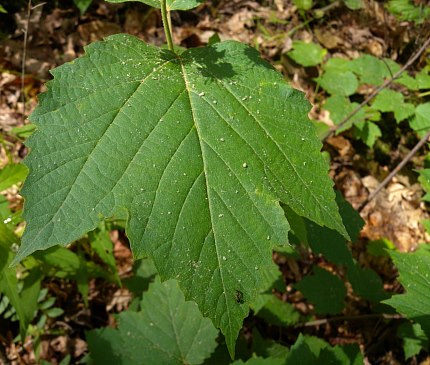Description: This woody shrub is 2-6' tall, branching occasionally. The bark of the trunk and larger branches is gray and slightly rough, while the bark of the small branches and twigs is gray or gray-brown and more smooth. Opposite pairs of leaves develop from new growth. These leaves are up to 5" long and 4" across; they are usually 3-lobed (less often unlobed), coarsely dentate, and approximately oval in shape. The lobes of the leaves have pointed tips, while the leaf bases are cordate or rounded. The upper leaf surface is medium green and hairless, while the lower surface is pale green and pubescent. The leaf petioles are pale green and pubescent. At the base of each petiole, there is usually a pair of small linear stipules, which may wither away with age.

The flat-headed
panicles (or compound cymes) of flowers develop from young branches.
Individual panicles span about 1½–3" across. Individual flowers are
about ¼" across, consisting of a white corolla with 5 petaloid lobes, a
short green calyx with 5 small teeth, 5 strongly exerted stamens, and a
central pistil. The blooming period occurs from late spring to
mid-summer and lasts about 3 weeks. The flowers are replaced by
ovoid-globoid berries about ¼" long that become blue-black at maturity.
Each berry contains a single seed (or stone). The root system is woody
and branching. During the fall, the leaves can assume different colors,
including pink, magenta, red, or orange.
Cultivation:
The preference is dappled sunlight to light shade, mesic to dry
conditions, and a somewhat acidic soil that is rocky or sandy. This
shrub will adapt to fertile loamy soil, but it is more likely to be
displaced by taller shrubs.
Range & Habitat:
The native Maple-Leaved Viburnum is occasional in northeast Illinois,
while in the
rest of the state it is rare or absent (see Distribution
Map). Habitats include upland rocky woodlands, upland sandy
woodlands, stabilized sand dunes with woody vegetation, and rocky
wooded slopes. This is an understory plant in high quality wooded
habitats where the shade is not too dense.

Faunal
Associations:
The nectar and pollen of the flowers attract Halictid bees, Andrenid
bees, miscellaneous other bees, Syrphid flies, dance flies (Empididae),
and miscellaneous other flies. To a lesser extent, the flowers are also
visited by wasps, beetles, butterflies, and skippers. The caterpillars
of several moths feed on Viburnums (primarily the foliage); see the Moth Table
for a listing of these species. Other insect feeders include the
caterpillars of the butterfly Celastrina argiolus
(Spring/Summer Azure), the introduced Pyrrhalta viburni
(Viburnum Leaf Beetle), the wood-boring larvae of Oberea
deficiens (Long-Horned Beetle sp.) and Oberea
tripunctata (Dogwood Twig Borer), and several aphid species.
Viburnum berries are eaten by the Ruffed Grouse and many woodland
songbirds (see Bird
Table). To a lesser extent, these berries are also eaten by
the White-Footed Mouse, Woodland Deer Mouse, Eastern Chipmunk, and
various tree squirrels. White-Tailed Deer may browse on the twigs and
leaves.
Photographic Location:
An upland rocky woodland at the Portland Arch in west-central Indiana,
where sandstone lies at or near the ground surface.

Comments: This is one of the smallest Viburnum spp., rarely exceeding 6' in height. The other small Viburnum sp. in Illinois, Viburnum rafinesquianum (Downy Arrow-Wood), has smaller leaves that lack pointed lobes. The only other native species in this genus that has pointed lobed leaves, Viburnum trilobum (American Cranberry Bush), has sterile white flowers that are much larger in size than the fertile flowers in the center of each inflorescence. There is also a very similar European species, Viburnum opulus (European Cranberry Bush), that also produces large sterile flowers; this latter species occasionally escapes from cultivation. The mature berries of these latter two species are shiny red. In contrast, Maple-Leaved Viburnum lacks such sterile flowers, and its mature berries are blue-black.